Case Study: Assessing Liability in Squelch Drinks Ltd. Injury Incident
VerifiedAdded on 2023/06/12
|8
|1594
|488
Case Study
AI Summary
This case study analyzes the legal liabilities arising from an employee injury at Squelch Drinks Ltd. Leonard, a technician, was seriously injured while repairing machinery when Jennifer, a director, restarted the equipment prematurely. The analysis explores primary liability, where the company could be directly liable if Jennifer acted with criminal intent, which is deemed not to be the case. Secondary liability, specifically vicarious liability, is examined, considering whether Jennifer's actions during her employment make the company liable for her negligence. The study also considers Jennifer's potential personal liability for negligence and Leonard's contributory negligence due to using his mobile phone during the repair. Finally, it touches upon potential compensation under the Worker’s Compensation Act, highlighting the responsibilities of companies towards their employees in workplace accidents. Desklib provides access to similar case studies and solved assignments for students.
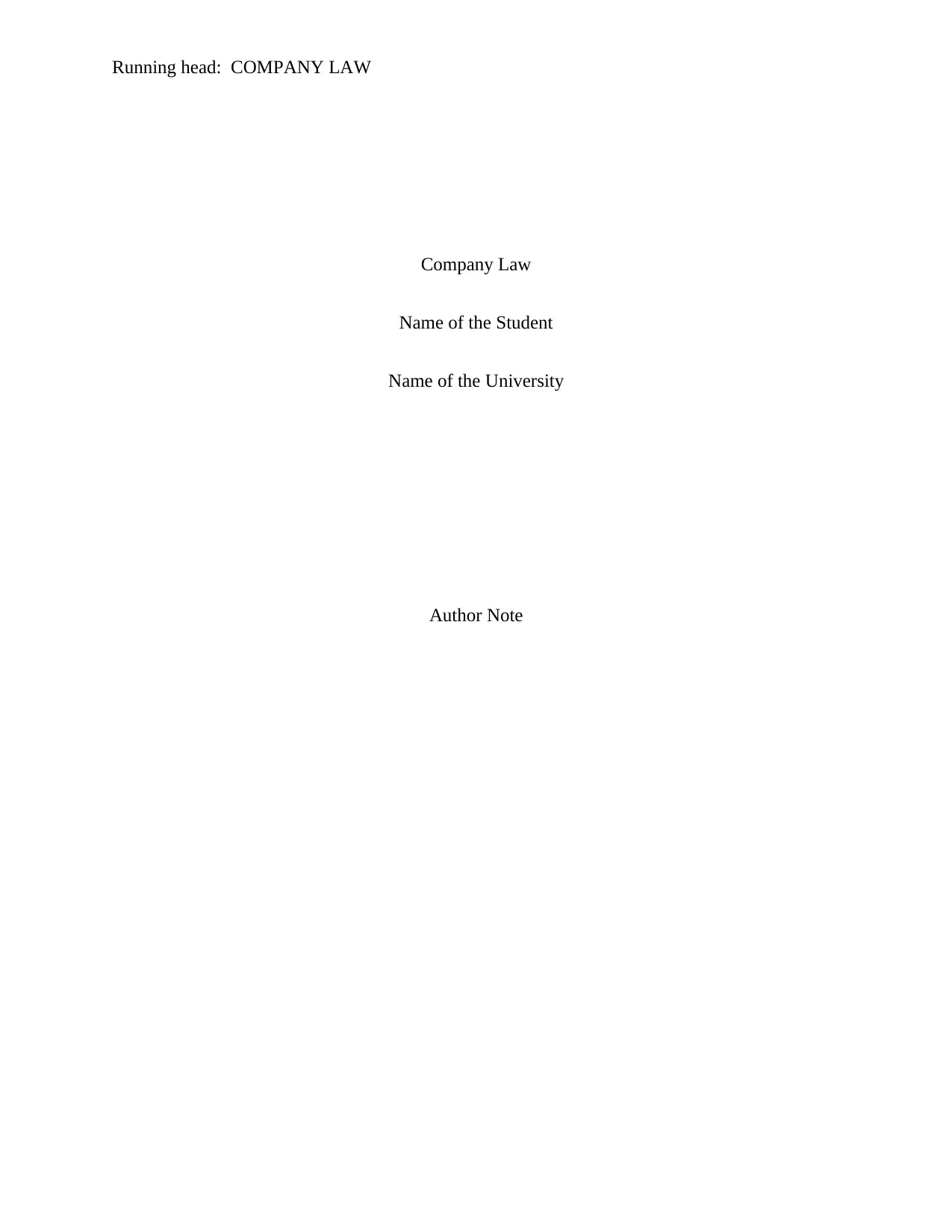
Running head: COMPANY LAW
Company Law
Name of the Student
Name of the University
Author Note
Company Law
Name of the Student
Name of the University
Author Note
Paraphrase This Document
Need a fresh take? Get an instant paraphrase of this document with our AI Paraphraser
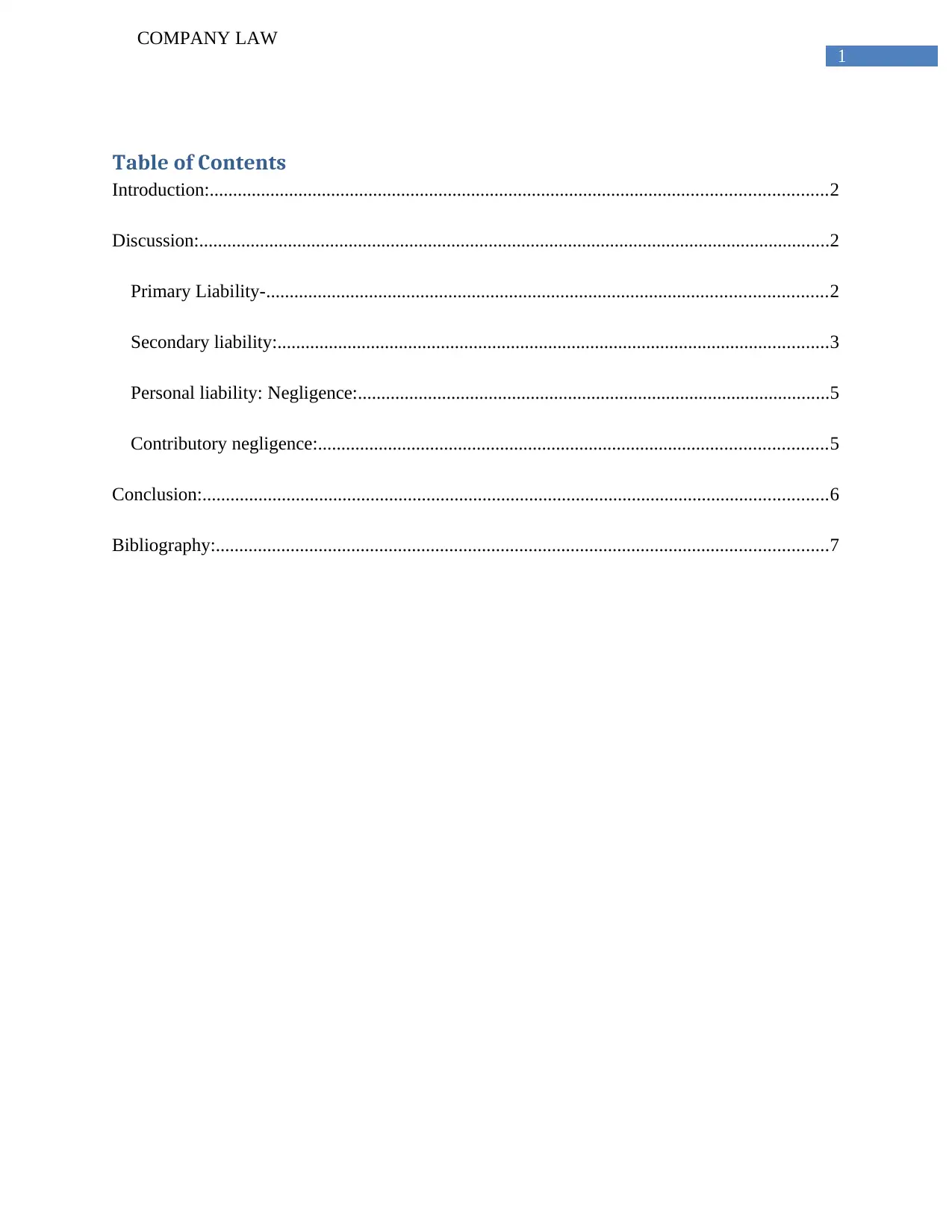
1
COMPANY LAW
Table of Contents
Introduction:....................................................................................................................................2
Discussion:.......................................................................................................................................2
Primary Liability-........................................................................................................................2
Secondary liability:......................................................................................................................3
Personal liability: Negligence:.....................................................................................................5
Contributory negligence:.............................................................................................................5
Conclusion:......................................................................................................................................6
Bibliography:...................................................................................................................................7
COMPANY LAW
Table of Contents
Introduction:....................................................................................................................................2
Discussion:.......................................................................................................................................2
Primary Liability-........................................................................................................................2
Secondary liability:......................................................................................................................3
Personal liability: Negligence:.....................................................................................................5
Contributory negligence:.............................................................................................................5
Conclusion:......................................................................................................................................6
Bibliography:...................................................................................................................................7
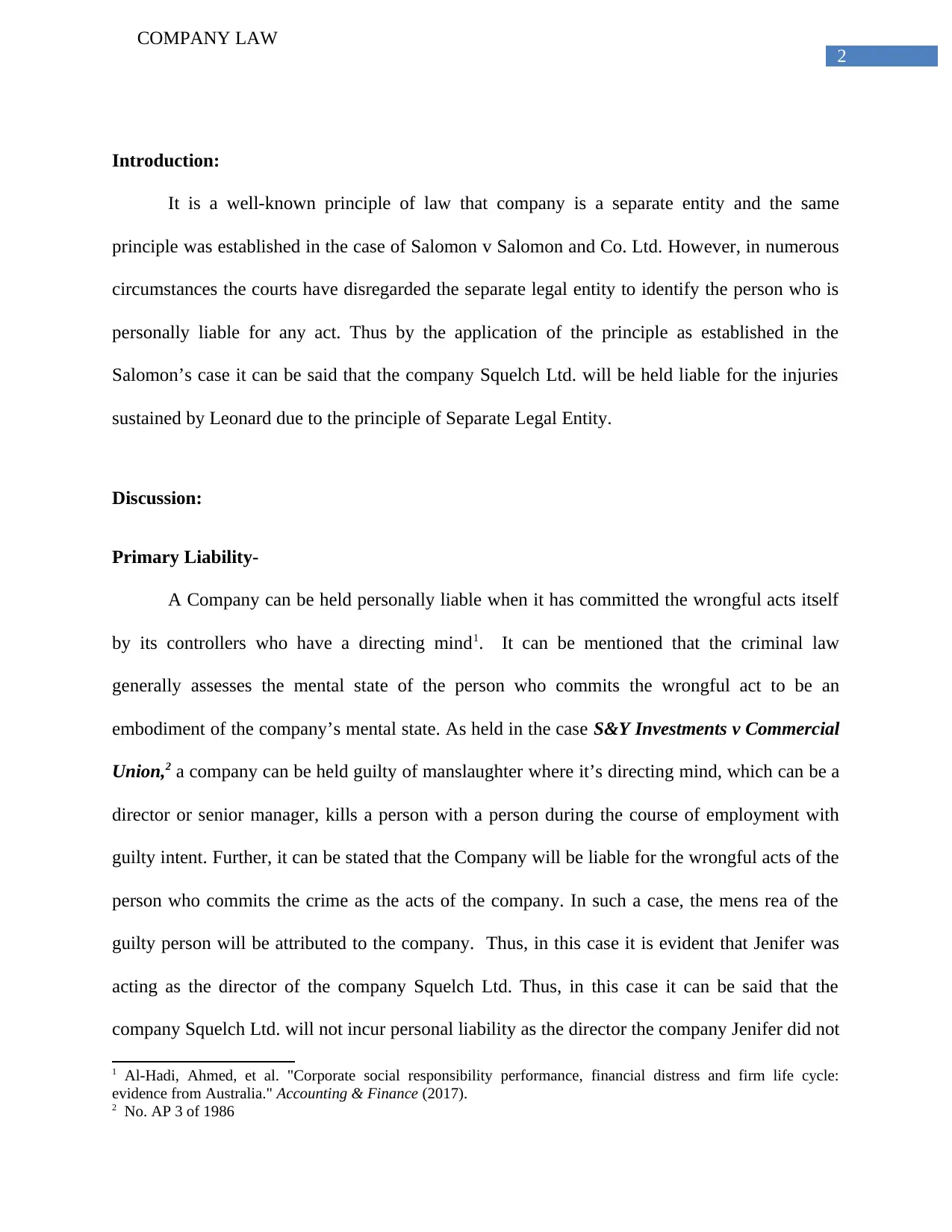
2
COMPANY LAW
Introduction:
It is a well-known principle of law that company is a separate entity and the same
principle was established in the case of Salomon v Salomon and Co. Ltd. However, in numerous
circumstances the courts have disregarded the separate legal entity to identify the person who is
personally liable for any act. Thus by the application of the principle as established in the
Salomon’s case it can be said that the company Squelch Ltd. will be held liable for the injuries
sustained by Leonard due to the principle of Separate Legal Entity.
Discussion:
Primary Liability-
A Company can be held personally liable when it has committed the wrongful acts itself
by its controllers who have a directing mind1. It can be mentioned that the criminal law
generally assesses the mental state of the person who commits the wrongful act to be an
embodiment of the company’s mental state. As held in the case S&Y Investments v Commercial
Union,2 a company can be held guilty of manslaughter where it’s directing mind, which can be a
director or senior manager, kills a person with a person during the course of employment with
guilty intent. Further, it can be stated that the Company will be liable for the wrongful acts of the
person who commits the crime as the acts of the company. In such a case, the mens rea of the
guilty person will be attributed to the company. Thus, in this case it is evident that Jenifer was
acting as the director of the company Squelch Ltd. Thus, in this case it can be said that the
company Squelch Ltd. will not incur personal liability as the director the company Jenifer did not
1 Al‐Hadi, Ahmed, et al. "Corporate social responsibility performance, financial distress and firm life cycle:
evidence from Australia." Accounting & Finance (2017).
2 No. AP 3 of 1986
COMPANY LAW
Introduction:
It is a well-known principle of law that company is a separate entity and the same
principle was established in the case of Salomon v Salomon and Co. Ltd. However, in numerous
circumstances the courts have disregarded the separate legal entity to identify the person who is
personally liable for any act. Thus by the application of the principle as established in the
Salomon’s case it can be said that the company Squelch Ltd. will be held liable for the injuries
sustained by Leonard due to the principle of Separate Legal Entity.
Discussion:
Primary Liability-
A Company can be held personally liable when it has committed the wrongful acts itself
by its controllers who have a directing mind1. It can be mentioned that the criminal law
generally assesses the mental state of the person who commits the wrongful act to be an
embodiment of the company’s mental state. As held in the case S&Y Investments v Commercial
Union,2 a company can be held guilty of manslaughter where it’s directing mind, which can be a
director or senior manager, kills a person with a person during the course of employment with
guilty intent. Further, it can be stated that the Company will be liable for the wrongful acts of the
person who commits the crime as the acts of the company. In such a case, the mens rea of the
guilty person will be attributed to the company. Thus, in this case it is evident that Jenifer was
acting as the director of the company Squelch Ltd. Thus, in this case it can be said that the
company Squelch Ltd. will not incur personal liability as the director the company Jenifer did not
1 Al‐Hadi, Ahmed, et al. "Corporate social responsibility performance, financial distress and firm life cycle:
evidence from Australia." Accounting & Finance (2017).
2 No. AP 3 of 1986
⊘ This is a preview!⊘
Do you want full access?
Subscribe today to unlock all pages.

Trusted by 1+ million students worldwide
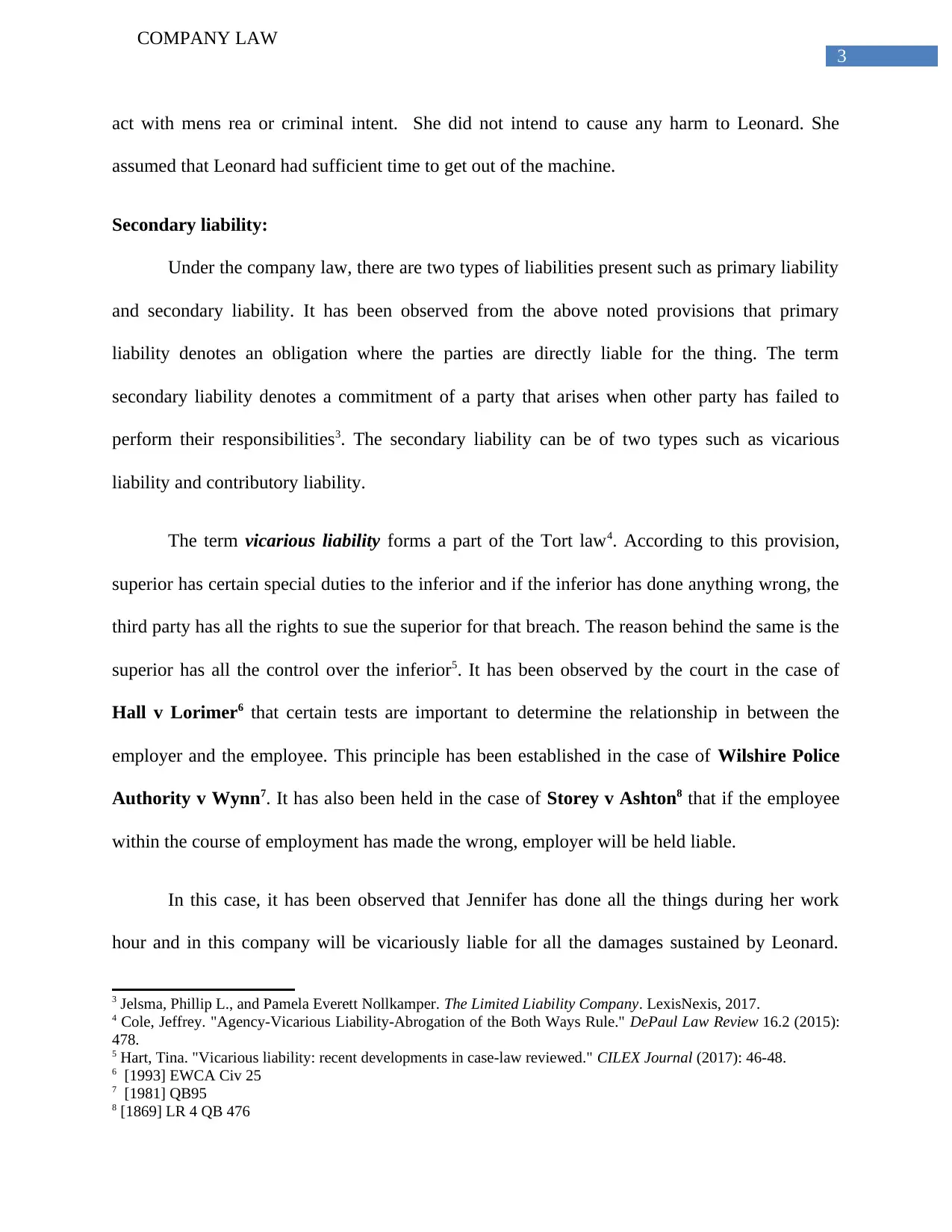
3
COMPANY LAW
act with mens rea or criminal intent. She did not intend to cause any harm to Leonard. She
assumed that Leonard had sufficient time to get out of the machine.
Secondary liability:
Under the company law, there are two types of liabilities present such as primary liability
and secondary liability. It has been observed from the above noted provisions that primary
liability denotes an obligation where the parties are directly liable for the thing. The term
secondary liability denotes a commitment of a party that arises when other party has failed to
perform their responsibilities3. The secondary liability can be of two types such as vicarious
liability and contributory liability.
The term vicarious liability forms a part of the Tort law4. According to this provision,
superior has certain special duties to the inferior and if the inferior has done anything wrong, the
third party has all the rights to sue the superior for that breach. The reason behind the same is the
superior has all the control over the inferior5. It has been observed by the court in the case of
Hall v Lorimer6 that certain tests are important to determine the relationship in between the
employer and the employee. This principle has been established in the case of Wilshire Police
Authority v Wynn7. It has also been held in the case of Storey v Ashton8 that if the employee
within the course of employment has made the wrong, employer will be held liable.
In this case, it has been observed that Jennifer has done all the things during her work
hour and in this company will be vicariously liable for all the damages sustained by Leonard.
3 Jelsma, Phillip L., and Pamela Everett Nollkamper. The Limited Liability Company. LexisNexis, 2017.
4 Cole, Jeffrey. "Agency-Vicarious Liability-Abrogation of the Both Ways Rule." DePaul Law Review 16.2 (2015):
478.
5 Hart, Tina. "Vicarious liability: recent developments in case-law reviewed." CILEX Journal (2017): 46-48.
6 [1993] EWCA Civ 25
7 [1981] QB95
8 [1869] LR 4 QB 476
COMPANY LAW
act with mens rea or criminal intent. She did not intend to cause any harm to Leonard. She
assumed that Leonard had sufficient time to get out of the machine.
Secondary liability:
Under the company law, there are two types of liabilities present such as primary liability
and secondary liability. It has been observed from the above noted provisions that primary
liability denotes an obligation where the parties are directly liable for the thing. The term
secondary liability denotes a commitment of a party that arises when other party has failed to
perform their responsibilities3. The secondary liability can be of two types such as vicarious
liability and contributory liability.
The term vicarious liability forms a part of the Tort law4. According to this provision,
superior has certain special duties to the inferior and if the inferior has done anything wrong, the
third party has all the rights to sue the superior for that breach. The reason behind the same is the
superior has all the control over the inferior5. It has been observed by the court in the case of
Hall v Lorimer6 that certain tests are important to determine the relationship in between the
employer and the employee. This principle has been established in the case of Wilshire Police
Authority v Wynn7. It has also been held in the case of Storey v Ashton8 that if the employee
within the course of employment has made the wrong, employer will be held liable.
In this case, it has been observed that Jennifer has done all the things during her work
hour and in this company will be vicariously liable for all the damages sustained by Leonard.
3 Jelsma, Phillip L., and Pamela Everett Nollkamper. The Limited Liability Company. LexisNexis, 2017.
4 Cole, Jeffrey. "Agency-Vicarious Liability-Abrogation of the Both Ways Rule." DePaul Law Review 16.2 (2015):
478.
5 Hart, Tina. "Vicarious liability: recent developments in case-law reviewed." CILEX Journal (2017): 46-48.
6 [1993] EWCA Civ 25
7 [1981] QB95
8 [1869] LR 4 QB 476
Paraphrase This Document
Need a fresh take? Get an instant paraphrase of this document with our AI Paraphraser
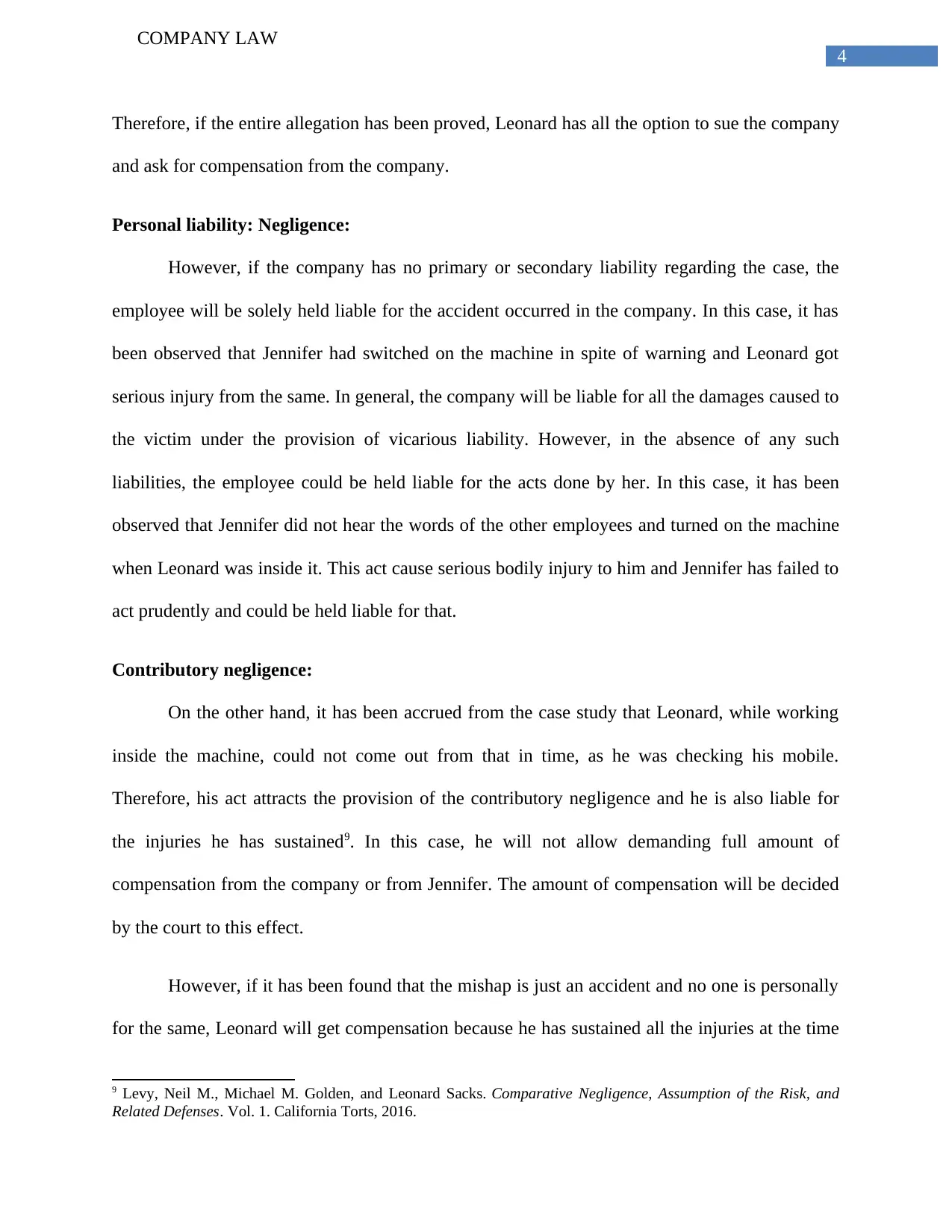
4
COMPANY LAW
Therefore, if the entire allegation has been proved, Leonard has all the option to sue the company
and ask for compensation from the company.
Personal liability: Negligence:
However, if the company has no primary or secondary liability regarding the case, the
employee will be solely held liable for the accident occurred in the company. In this case, it has
been observed that Jennifer had switched on the machine in spite of warning and Leonard got
serious injury from the same. In general, the company will be liable for all the damages caused to
the victim under the provision of vicarious liability. However, in the absence of any such
liabilities, the employee could be held liable for the acts done by her. In this case, it has been
observed that Jennifer did not hear the words of the other employees and turned on the machine
when Leonard was inside it. This act cause serious bodily injury to him and Jennifer has failed to
act prudently and could be held liable for that.
Contributory negligence:
On the other hand, it has been accrued from the case study that Leonard, while working
inside the machine, could not come out from that in time, as he was checking his mobile.
Therefore, his act attracts the provision of the contributory negligence and he is also liable for
the injuries he has sustained9. In this case, he will not allow demanding full amount of
compensation from the company or from Jennifer. The amount of compensation will be decided
by the court to this effect.
However, if it has been found that the mishap is just an accident and no one is personally
for the same, Leonard will get compensation because he has sustained all the injuries at the time
9 Levy, Neil M., Michael M. Golden, and Leonard Sacks. Comparative Negligence, Assumption of the Risk, and
Related Defenses. Vol. 1. California Torts, 2016.
COMPANY LAW
Therefore, if the entire allegation has been proved, Leonard has all the option to sue the company
and ask for compensation from the company.
Personal liability: Negligence:
However, if the company has no primary or secondary liability regarding the case, the
employee will be solely held liable for the accident occurred in the company. In this case, it has
been observed that Jennifer had switched on the machine in spite of warning and Leonard got
serious injury from the same. In general, the company will be liable for all the damages caused to
the victim under the provision of vicarious liability. However, in the absence of any such
liabilities, the employee could be held liable for the acts done by her. In this case, it has been
observed that Jennifer did not hear the words of the other employees and turned on the machine
when Leonard was inside it. This act cause serious bodily injury to him and Jennifer has failed to
act prudently and could be held liable for that.
Contributory negligence:
On the other hand, it has been accrued from the case study that Leonard, while working
inside the machine, could not come out from that in time, as he was checking his mobile.
Therefore, his act attracts the provision of the contributory negligence and he is also liable for
the injuries he has sustained9. In this case, he will not allow demanding full amount of
compensation from the company or from Jennifer. The amount of compensation will be decided
by the court to this effect.
However, if it has been found that the mishap is just an accident and no one is personally
for the same, Leonard will get compensation because he has sustained all the injuries at the time
9 Levy, Neil M., Michael M. Golden, and Leonard Sacks. Comparative Negligence, Assumption of the Risk, and
Related Defenses. Vol. 1. California Torts, 2016.
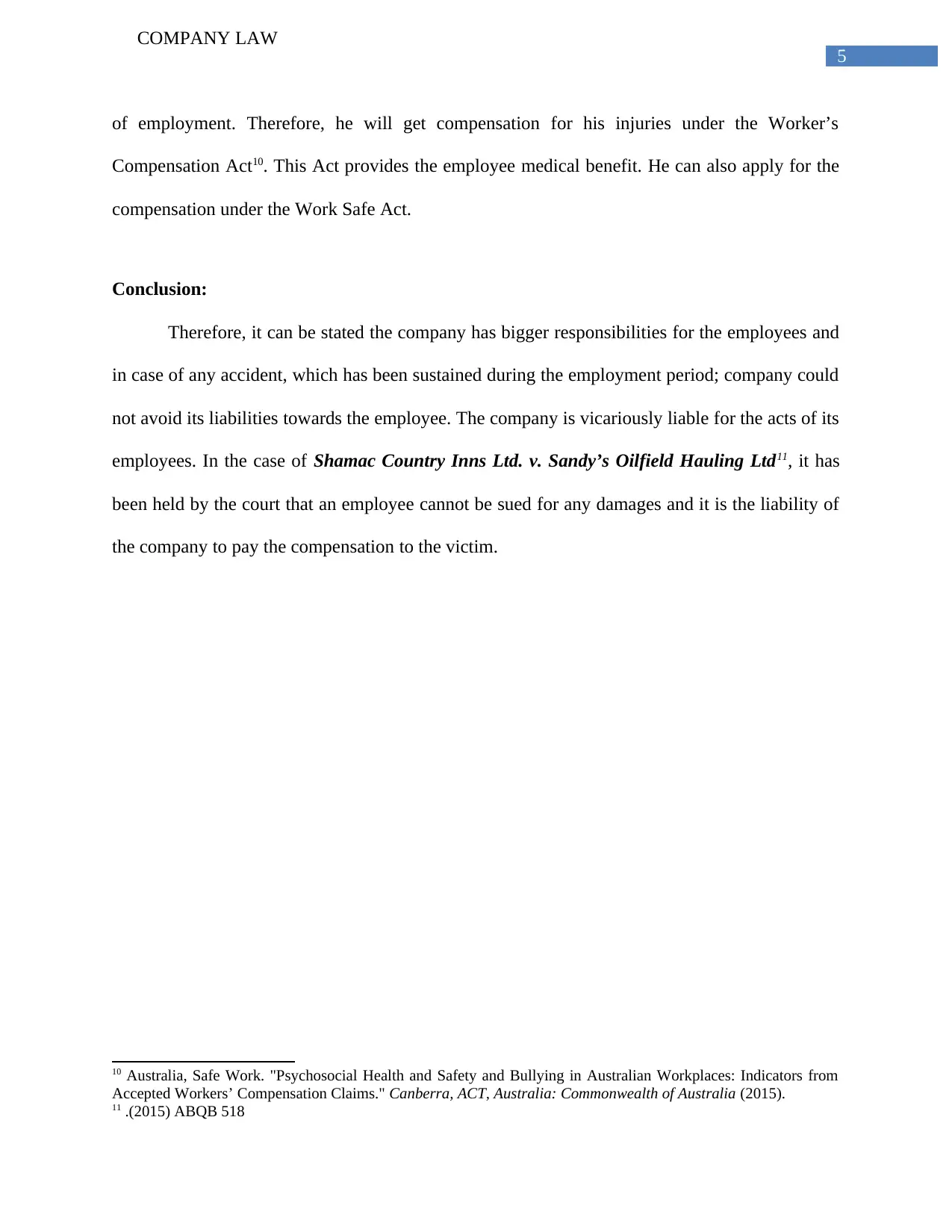
5
COMPANY LAW
of employment. Therefore, he will get compensation for his injuries under the Worker’s
Compensation Act10. This Act provides the employee medical benefit. He can also apply for the
compensation under the Work Safe Act.
Conclusion:
Therefore, it can be stated the company has bigger responsibilities for the employees and
in case of any accident, which has been sustained during the employment period; company could
not avoid its liabilities towards the employee. The company is vicariously liable for the acts of its
employees. In the case of Shamac Country Inns Ltd. v. Sandy’s Oilfield Hauling Ltd11, it has
been held by the court that an employee cannot be sued for any damages and it is the liability of
the company to pay the compensation to the victim.
10 Australia, Safe Work. "Psychosocial Health and Safety and Bullying in Australian Workplaces: Indicators from
Accepted Workers’ Compensation Claims." Canberra, ACT, Australia: Commonwealth of Australia (2015).
11 .(2015) ABQB 518
COMPANY LAW
of employment. Therefore, he will get compensation for his injuries under the Worker’s
Compensation Act10. This Act provides the employee medical benefit. He can also apply for the
compensation under the Work Safe Act.
Conclusion:
Therefore, it can be stated the company has bigger responsibilities for the employees and
in case of any accident, which has been sustained during the employment period; company could
not avoid its liabilities towards the employee. The company is vicariously liable for the acts of its
employees. In the case of Shamac Country Inns Ltd. v. Sandy’s Oilfield Hauling Ltd11, it has
been held by the court that an employee cannot be sued for any damages and it is the liability of
the company to pay the compensation to the victim.
10 Australia, Safe Work. "Psychosocial Health and Safety and Bullying in Australian Workplaces: Indicators from
Accepted Workers’ Compensation Claims." Canberra, ACT, Australia: Commonwealth of Australia (2015).
11 .(2015) ABQB 518
⊘ This is a preview!⊘
Do you want full access?
Subscribe today to unlock all pages.

Trusted by 1+ million students worldwide
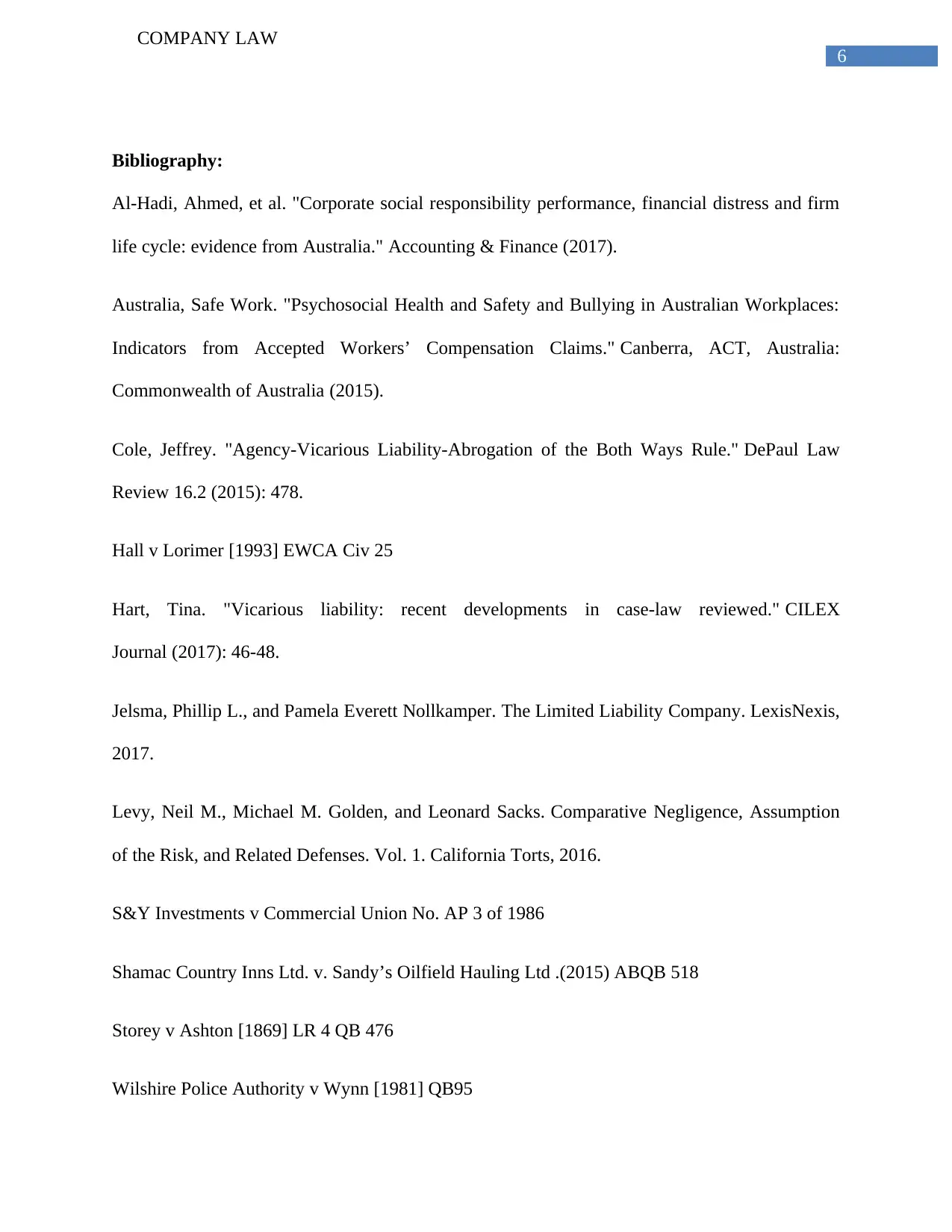
6
COMPANY LAW
Bibliography:
Al‐Hadi, Ahmed, et al. "Corporate social responsibility performance, financial distress and firm
life cycle: evidence from Australia." Accounting & Finance (2017).
Australia, Safe Work. "Psychosocial Health and Safety and Bullying in Australian Workplaces:
Indicators from Accepted Workers’ Compensation Claims." Canberra, ACT, Australia:
Commonwealth of Australia (2015).
Cole, Jeffrey. "Agency-Vicarious Liability-Abrogation of the Both Ways Rule." DePaul Law
Review 16.2 (2015): 478.
Hall v Lorimer [1993] EWCA Civ 25
Hart, Tina. "Vicarious liability: recent developments in case-law reviewed." CILEX
Journal (2017): 46-48.
Jelsma, Phillip L., and Pamela Everett Nollkamper. The Limited Liability Company. LexisNexis,
2017.
Levy, Neil M., Michael M. Golden, and Leonard Sacks. Comparative Negligence, Assumption
of the Risk, and Related Defenses. Vol. 1. California Torts, 2016.
S&Y Investments v Commercial Union No. AP 3 of 1986
Shamac Country Inns Ltd. v. Sandy’s Oilfield Hauling Ltd .(2015) ABQB 518
Storey v Ashton [1869] LR 4 QB 476
Wilshire Police Authority v Wynn [1981] QB95
COMPANY LAW
Bibliography:
Al‐Hadi, Ahmed, et al. "Corporate social responsibility performance, financial distress and firm
life cycle: evidence from Australia." Accounting & Finance (2017).
Australia, Safe Work. "Psychosocial Health and Safety and Bullying in Australian Workplaces:
Indicators from Accepted Workers’ Compensation Claims." Canberra, ACT, Australia:
Commonwealth of Australia (2015).
Cole, Jeffrey. "Agency-Vicarious Liability-Abrogation of the Both Ways Rule." DePaul Law
Review 16.2 (2015): 478.
Hall v Lorimer [1993] EWCA Civ 25
Hart, Tina. "Vicarious liability: recent developments in case-law reviewed." CILEX
Journal (2017): 46-48.
Jelsma, Phillip L., and Pamela Everett Nollkamper. The Limited Liability Company. LexisNexis,
2017.
Levy, Neil M., Michael M. Golden, and Leonard Sacks. Comparative Negligence, Assumption
of the Risk, and Related Defenses. Vol. 1. California Torts, 2016.
S&Y Investments v Commercial Union No. AP 3 of 1986
Shamac Country Inns Ltd. v. Sandy’s Oilfield Hauling Ltd .(2015) ABQB 518
Storey v Ashton [1869] LR 4 QB 476
Wilshire Police Authority v Wynn [1981] QB95
Paraphrase This Document
Need a fresh take? Get an instant paraphrase of this document with our AI Paraphraser
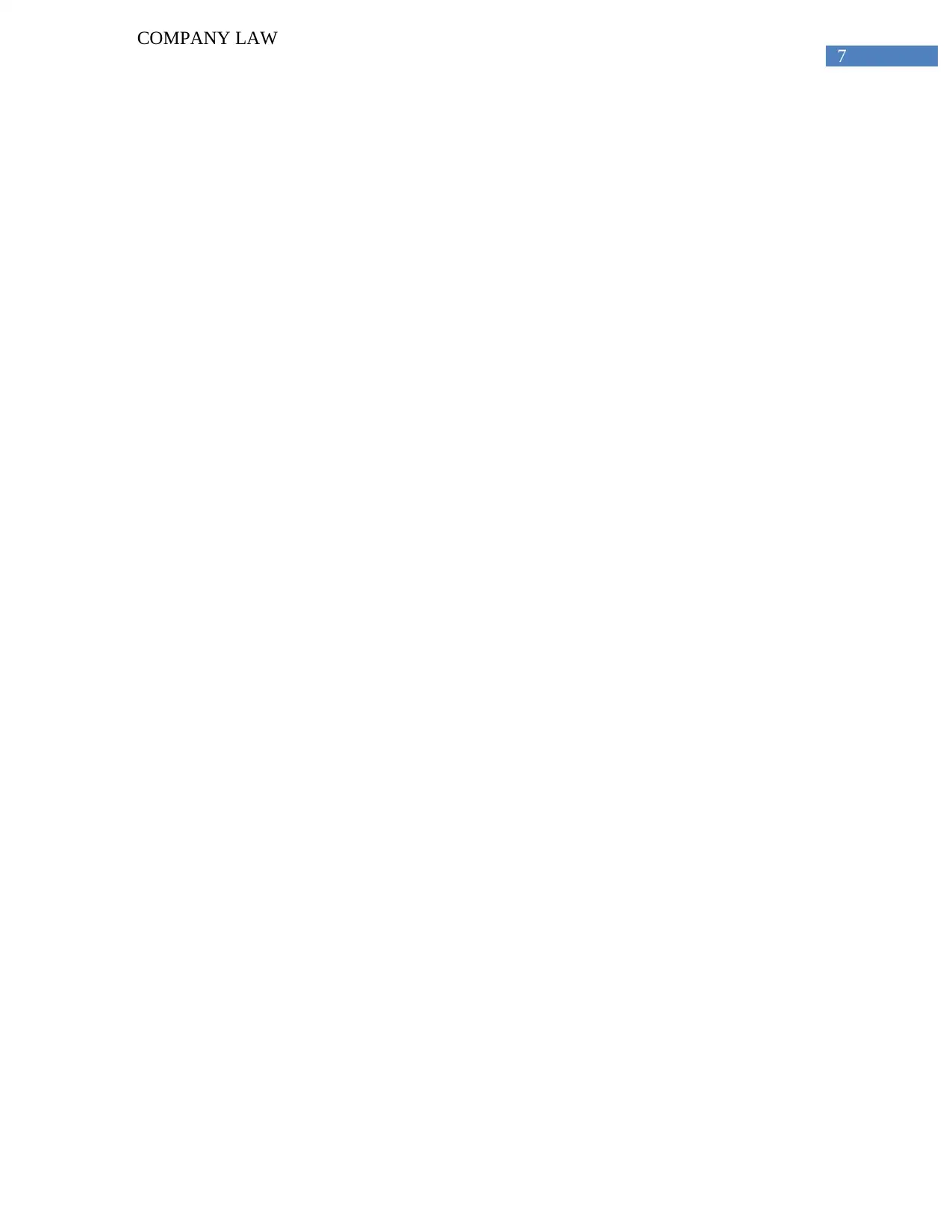
7
COMPANY LAW
COMPANY LAW
1 out of 8
Related Documents
Your All-in-One AI-Powered Toolkit for Academic Success.
+13062052269
info@desklib.com
Available 24*7 on WhatsApp / Email
![[object Object]](/_next/static/media/star-bottom.7253800d.svg)
Unlock your academic potential
Copyright © 2020–2025 A2Z Services. All Rights Reserved. Developed and managed by ZUCOL.





